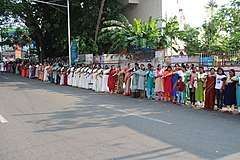Vanitha Mathil
Vanitha Mathil ("Women's Wall") was a human chain formed on 1 January 2019 across the Indian state of Kerala to uphold gender equality and protest against gender discrimination. The wall was formed solely by women and extended for a distance of around 620 kilometres (390 miles) from Kasargod to Thiruvanathapuram.[1][2][3] Around three to five million women participated in the event.[4][5]
 Women's Wall at Kollam | |
| Date | 1 January 2019 |
|---|---|
| Location | Kerala, India |
| Type | Human chain |
| Motive | To uphold gender equality and protest against gender discrimination in entry rules at Sabarimala |
| Organised by | Government of Kerala |
| Participants | Exact number not known |
Background
In Kerala, the Hindu temple at Sabarimala traditionally barred women between the ages of 10 and 50 from entering to worship Ayyappa. Some people claimed women were barred because menstruation is impure, but devotees claimed they are not allowed because of the celibate nature of the deity.[6][7] In September 2018, the Supreme Court of India, in a historic verdict, allowed women of all ages to enter the temple, stating that any discrimination based on biological differences is clearly unconstitutional.[8] The ruling coalition of the state Left Democratic Front welcomed the judgment, while opposition parties like the Bharatiya Janata Party and the Indian National Congress launched protests opposing the verdict.[9] Many Hindu groups protested against the judgment and the state government's decision to implement it.[10]
Wall
On 15 December 2018, Kerala's Chief Minister Pinarayi Vijayan announced after meeting with 176 social and political organisations that the women's wall would be held on New Year's Day to protect the renaissance values of the state.[11][12] A theme song for the event by Prabha Varma was released.[13]
On 1 January 2019 at 4:00 pm, the wall was formed by around three to five million women along the national highways of the state of Kerala for around 620 kilometres (390 miles).[14] The wall began in the northern end of the state by Kerala's Minister of Health and Social Justice K. K. Shailaja in Kasargod, and ended in Thiruvanathapuram in the south with Brinda Karat, leader of the Communist Party of India.[1] Activists of the Rashtriya Swayamsevak Sangh and the Bharatiya Janata Party reportedly tried to attack the wall in Kasargod.[15]
On the same day, in support of the event in Kerala, women's walls were organised in solidarity with Vanitha Mathil in other Indian cities, including New Delhi,[16] Mumbai,[17] and Chennai.[18]
The women's wall in Kerala became the world's fourth largest human chain ever made, and the largest formed solely by women.[19]
References
- "Women's Wall highlights: Massive turnout in Kerala for equal rights". The Times of India. 1 January 2019. Archived from the original on 1 January 2019. Retrieved 1 January 2019.
- "Sabarimala row: Lakhs to form 'women's wall' in Kerala". The Economic Times. 1 January 2019. Archived from the original on 1 January 2019. Retrieved 1 January 2019.
- "Women's wall in Kerala HIGHLIGHTS: Lakhs of women line up for 'Vanitha Mathil' across state". The Indian Express. 1 January 2019. Archived from the original on 1 January 2019. Retrieved 1 January 2019.
- "Lakhs Of Women Join Hands To Form 620-Km "Human Wall For Equality" In Kerala". NDTV. 1 January 2019. Archived from the original on 2 January 2019. Retrieved 2 January 2019.
- "Kerala wall: 50 lakh women form 620-km Vanitha Mathil, take pledge to uphold gender equality". India Today. 1 January 2019. Archived from the original on 3 January 2019. Retrieved 2 January 2019.
- "India's top court strikes down ban on 'menstruating' women entering Hindu holy site". The Independent. 28 September 2018.
- "Celibate nature of Lord Ayyappa of Sabarimala temple protected by Constitution, SC told". Times of India. 25 July 2018. Archived from the original on 11 January 2019. Retrieved 11 January 2019.
- "Sabarimala temple: India's top court revokes ban on women". BBC. 28 September 2018. Archived from the original on 5 January 2019. Retrieved 1 January 2019.
- "Women have the same right to worship as men: Pinarayi Vijayan on Sabarimala issue". India Today. 17 October 2018. Archived from the original on 21 November 2018. Retrieved 1 January 2019.
- "Sabarimala women entry: Hindu outfits to intensify stir". Times of India. 11 October 2018. Archived from the original on 12 October 2018. Retrieved 1 January 2019.
- "Kerala gears up for massive Women's Wall event: All you need to know". The News Minute. 31 December 2018. Archived from the original on 3 January 2019. Retrieved 2 January 2019.
- "It's official: 'Women's wall' is a state govt programme". Times of India. 6 December 2018.
- "Slew of spirited musical expression for women's wall". United News of India. 29 December 2018. Archived from the original on 3 January 2019. Retrieved 2 January 2019.
- "Sabarimala temple: Indian women form '620km human chain' for equality". BBC News. BBC. January 2019. Archived from the original on 2 January 2019. Retrieved 3 January 2019.
- "Suspected RSS-BJP workers attack women's wall at Kasargod's Chettukund; journalists assaulted". The New Indian Express. Archived from the original on 2 January 2019. Retrieved 1 January 2019.
- "Sabarimala row HIGHLIGHTS: Delhi women support 'Women's wall' campaign, demonstrate outside Kerala House". Hindustan Times. 2 January 2019.
- "Women form human chain in Mumbai to support Kerala 'Women's Wall'". The Economic Times. 2 January 2019.
- "Chennai women form Vanitha Mathil in solidarity with Kerala Women's Wall". The New Indian Express. 1 January 2019. Archived from the original on 6 January 2019. Retrieved 6 January 2019.
- "In case you haven't noticed yet, the women's wall in Kerala was the fourth largest human chain ever". News 18. Archived from the original on 3 January 2019. Retrieved 2 January 2019.